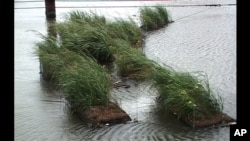Water may be the source of life, but its life-giving quality depends on how we treat it. Farm runoff, pesticides and fertilizers, even treated wastewater make their way back into our waters and our lives.
But at the Port of Baltimore in Maryland, the National Aquarium has a pilot program that could help improve the water below its piers. An island made of garbage.
"This is a floating island here in the Baltimore harbor," says Laura Bankey, the aquarium's conservation manager. "These technologies have been used in other systems. And there is an estimate that one acre (.4 hectares) of these wetlands would equal 200 acres (81 hectares) of natural wetlands, which in themselves have tremendous habitat value and water quality value."
Bankey says the little floating trash island was put together in just a few hours. Native plants are planted in a plastic mesh, then anchored into place.
"The plants themselves will actually grow through the island material and take up nutrients from the water. And that's really what's causing a lot of our problems here in the Chesapeake bay. Those excess nutrients are causing fish die-offs and dead zones and some other things. So we're trying to prove that new technologies like this can improve water quality here."
Just adjacent to the National Aquarium are more floating wetlands - same goal, different design. A separate organization put those in - but the National Aquarium will lead the monitoring of both sites.
These man-made islands are not exactly new technology, but Kevin Hedge says they are an evolving practice. Hedge is a managing partner of BlueWing Environmental Solutions and Technologies. He says his company began putting in these floating wetlands for commercial use a few years ago.
"Floating wetlands themselves have been around for thousands of years around the world," he says. "People in the Amazon live on them and they recognize the value of them. Floating Island International has been around about ten years, working on and continuing to develop the technology. Five years of research went into the current embodiment of what we're working with today."
The man-made islands are meant to mimic nature - natural wetlands that occur all around the world. And they seem to be doing a pretty good job - turtles like them, ducks like them and underwater there are even more creatures clinging to them.
"We have lots of dark mussels that are down there, lots of worms and other small critters," says Laura Bankey. "We have pictures of blue crabs just hanging out on the bottom of the island having lunch. We have pictures of striped bass coming in and eating some of the critters that are on the island. And, as you can see it's a favorite of the local ducks."
And, a favorite of the local people. Once the plants grow to full size, it's hard to tell this"BioHaven" floating island is made of plastic.
"It's made of 100 percent recycled plastic material, bonded together with layers of marine grade buoyant foam. It's adds some buoyancy to it and some rigidity," says Kevin Hedge. "A typical island has wicking channels in it - three per square foot (30cm) - these are designed to wick up water from the ecosystem that you put it in and feed aquatic growth and bio-film growth, bacteria growth in the system."
That bacteria growth helps clean the water of excess nutrients that wash into the water, such as nitrogen and phosphorus, blamed for a number of water-related troubles, including algae blooms and low oxygen levels.
You can watch all of Rebecca's "Going Green" video reports by clicking here.






